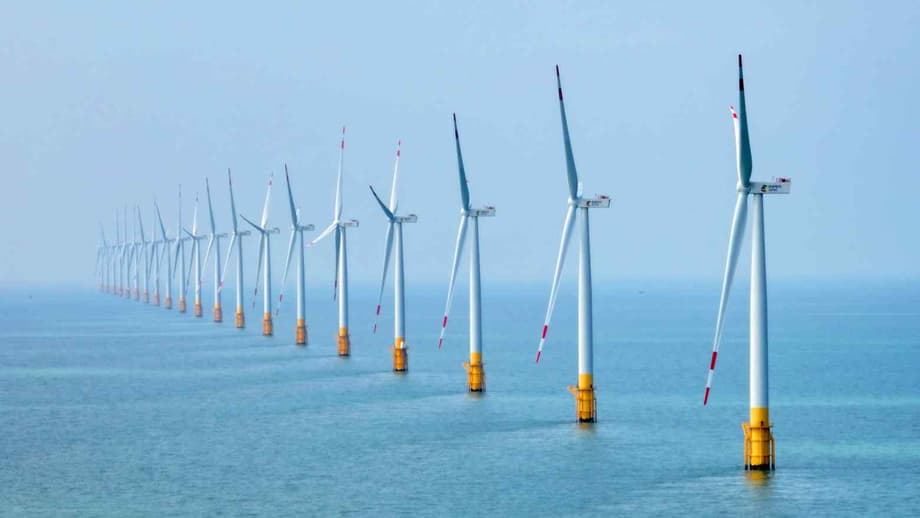Why China is racing ahead in offshore wind
China is expanding offshore wind at a pace unmatched by other major economies, a surge driven by state support, low turbine prices from domestic manufacturers, and a deep pipeline of projects along its eastern seaboard. Industry forecasts suggest China will account for about half of new offshore wind capacity built through 2030. Independent research also projects that China could hold around 45 percent of the world’s cumulative offshore wind capacity by 2030. This places the country at the center of a technology many governments view as essential for clean power and energy security.
- Why China is racing ahead in offshore wind
- The numbers behind the lead
- Policy, pricing and manufacturing advantage
- Provincial buildout from Guangdong to Hainan
- Global context, United States headwinds and European recalibration
- Offshore wind and China’s digital economy
- Environmental gains and grid integration
- What to watch through 2030
- Key Points
Momentum in China contrasts with a mixed picture elsewhere. Some markets have slowed because of inflation, higher interest rates, and project cancellations. China’s scale, established supply chain, and policy continuity have helped keep project costs competitive, while grid operators connect large coastal wind farms to energy hungry regions powered by heavy industry and growing digital infrastructure.
Offshore wind is also becoming a strategic tool for powering technology clusters on the coast, from advanced manufacturing to data centers. That combination of industrial demand, policy targets, and supply chain depth explains why China is set to dominate the next phase of global offshore wind construction.
The numbers behind the lead
The global offshore wind fleet reached roughly 83 gigawatts by the end of 2024 after 8 gigawatts were connected in that year, according to international industry tallies. Government auctions awarded a record wave of future capacity, and nearly 50 gigawatts of projects are already under construction worldwide. Forecasts point to annual offshore wind installations rising from single digits in the mid 2020s to about 34 gigawatts in 2030.
China has been the largest builder of offshore wind for several years running. By mid 2023 it had more than 31 gigawatts operating offshore, more than any other country. Near term growth is concentrated in China and Europe, with Asia Pacific markets such as Japan and South Korea also advancing policy frameworks and grid upgrades to bring projects online later in the decade.
By 2030, one leading energy consultancy expects China to command about 45 percent of cumulative global offshore wind capacity. Another common estimate across the sector is that half of new offshore wind additions between now and 2030 will be in China. Both views underscore the country’s central role in meeting global wind targets.
How much market share could China hold by 2030
Share of new additions and share of cumulative capacity are different lenses on the same trend. If global annual installations scale to the low to mid 30 gigawatts by 2030 and China continues to build at a double digit gigawatt pace each year, the country’s market share remains large even as more nations begin adding projects. In short, the faster the global market grows, the more room there is for multiple regions to expand, yet China’s build rate keeps it in a commanding position.
Policy, pricing and manufacturing advantage
Policy clarity has been a key enabler. China’s energy planners have used five year plans, auctions, and grid connection mandates to steer investment. Recent policy shifts encourage market based pricing for renewable electricity, a change designed to improve project bankability while aligning developer incentives with grid needs. Stable rules help lower financing risks for projects that can take several years to build and connect.
Manufacturing capacity is another advantage. Global wind factories could produce on the order of 170 to 180 gigawatts of equipment in 2023, with China the main hub. That footprint includes blades, towers, nacelles, and a growing list of offshore foundations and cables. Scale helps cut costs, and Chinese original equipment manufacturers have rolled out larger turbines that reduce the number of units needed for each project, lowering installation and maintenance costs per megawatt.
Lower supply chain costs feed through to the levelized cost of electricity, a measure that captures the full cost of building and operating a plant over its lifetime. Combined with improvements in project design, installation vessels, and port logistics, developers can deliver more capacity for each yuan invested. That cost edge has widened as some Western markets face higher interest rates and currency volatility.
Why turbine costs are lower in China
Domestic competition between several turbine makers, access to a dense network of component suppliers, and proximity to coastal project sites all reduce transport and logistics expenses. Developers also benefit from shorter development timelines and established port infrastructure that can handle ever larger components. These factors tighten bid prices in auctions and enable projects to proceed even in a tougher global funding environment.
Provincial buildout from Guangdong to Hainan
China’s first wave of offshore wind concentrated in a handful of coastal provinces. About three quarters of the country’s operating offshore capacity sits in Jiangsu, Guangdong, and Fujian. Project pipelines now stretch north and south along the coast, including major plans in Zhejiang and Shandong and new activity off Hainan Island.
Guangdong stands out. Provincial planning documents and academic assessments indicate that Guangdong aims to build 23 offshore wind farms totaling about 66.9 gigawatts by 2030. Earlier blueprints designated several provinces as offshore wind power bases to 2025, including Fujian, Shandong, Zhejiang, and Jiangsu, each with multi gigawatt prospective capacity. China’s national oil company CNOOC is also scaling up in offshore wind, with a 1.5 gigawatt project in the Hainan CZ7 zone targeted for commissioning before 2030.
Guangdong’s 66.9 GW plan by 2030
Guangdong is a major manufacturing and technology hub, and it sits near strong wind resources in the South China Sea. Building tens of gigawatts of capacity gives the province a pathway to supply clean power to industrial clusters and data driven businesses. Delivering that buildout will require strong grid connections, energy storage that can shift power to night hours, and coordinated port logistics for a steady flow of components.
Global context, United States headwinds and European recalibration
The United States, once expected to scale fast, has struggled with policy reversals, higher costs, and legal challenges. Stop work orders hit prominent projects in the Northeast before some restrictions were lifted. Renewable energy investment fell sharply in early 2025, and developers reassessed exposure to the US market. These setbacks have slowed the pace of construction and dented confidence for near term auctions.
European investors have redirected capital and are seeking more predictable frameworks after a spell of failed auctions and cost spikes. Policymakers in Europe are also trying to reduce reliance on imports from China by supporting domestic factories for blades, nacelles, towers, and cables. The challenge is not trivial. A sizeable share of manufacturing sites that produce key components for Western turbine platforms are located in China, which makes rapid reshoring difficult without higher costs to consumers.
What this means for supply chains
Supply chains balance cost, quality, and resilience. China’s manufacturing breadth makes it hard to replace quickly, yet a more diversified global footprint would reduce bottlenecks. Expect governments to adjust auction rules to share risks better between developers and offtakers, while also funding ports, grids, and workforce training that underpin construction timelines.
Offshore wind and China’s digital economy
Offshore wind is increasingly linked to data centers and industrial parks that need low carbon, around the clock power. Shanghai’s Lin gang Special Area offers a vivid case. The first phase of an underwater data center there has a power capacity of about 24 megawatts and is designed to run almost entirely on electricity from nearby offshore wind farms. Cooling is achieved by submerging server modules in the sea, dramatically cutting the electricity required for air conditioning.
Inside the undersea data center
Project leaders say the system’s energy efficiency is designed to reach a power usage effectiveness of no more than 1.15, compared with typical land facilities that often rely heavily on air conditioning. Su Yang, general manager of Shanghai Hicloud Technology, one of the contractors, explained how the site exploits its marine setting.
Su Yang said: “Seawater acts as a natural cooling system, which reduces the energy demand for cooling to less than 10 percent.”
Huang Dinan, president of Shenergy Group, another contractor, pointed to the quality of the local wind resource and why it matters for stable operations.
Huang Dinan said: “The East China Sea offers unique offshore wind resources with more than 3,000 hours of annual utilization.”
Scaling up brings new challenges
The project partners have signed an agreement to pursue a much larger wind powered underwater data center of about 500 megawatts. Turning a pilot into a utility scale system will require careful engineering and operational learning. Wang Shifeng, president of Third Harbor Engineering, stressed the need for step by step improvement.
Wang Shifeng said: “For broader deployment, operation and maintenance optimization, as well as technological reliability, must be achieved first.”
Environmental gains and grid integration
China’s coastline holds vast wind resources. Researchers estimate offshore wind could generate around 17.5 petawatt hours each year at technical potential, more than double China’s current national power consumption. If development continues through mid century, avoided coal use could reduce emissions by roughly 294 million tons of carbon dioxide equivalent per year in coastal regions. That is greater than the total annual emissions of most countries.
Bringing large volumes of offshore wind onto the grid is not only about turbines at sea. It requires strong transmission lines, upgraded substations, digital controls, and storage. Curtailment falls when grids can move and store power efficiently. China has begun to adopt market based electricity pricing for renewables, which can reward flexible demand and storage that smooths peaks and valleys in wind generation. International agencies expect the share of renewables in the power mix to climb steadily to 2030, with wind becoming a leading source after solar power.
Fixed bottom versus floating wind
Most of China’s offshore turbines sit on foundations fixed to the seabed in relatively shallow waters. Floating wind platforms, which can unlock deeper seas with stronger winds, are still a small fraction of global capacity, measured in the hundreds of megawatts. Several Chinese developers and research institutes are testing floating designs. If costs lower with scale, floating wind could open new zones beyond shallow continental shelves.
What to watch through 2030
The global industry is expected to connect more than 30 gigawatts of offshore wind in 2030, with annual additions growing again after a period of cost pressure. Developers and governments are redesigning auction systems to share risks more evenly, improve indexation to costs, and secure power purchase agreements that back long term financing. Port expansions, cable factories, and installation vessels will need to keep pace.
In China, provincial plans point to another wave of projects in Guangdong, Jiangsu, Fujian, Zhejiang, Shandong, and Hainan. Industry targets call for at least 15 gigawatts of new offshore capacity each year during 2026 to 2030. State backed developers are moving from near shore to deeper waters, while oil and gas companies enter the market with large projects such as the Hainan CZ7 site. Grid operators are investing in new subsea links and onshore reinforcements to move power into urban and industrial load centers.
Key risks bear watching. Interest rates and supply chain constraints can lift bid prices. Transmission delays can bottleneck new capacity. Local content rules may push costs higher in some markets even as they build domestic skills. On the other hand, continued learning in turbine design, foundations, and operations can keep costs in check. If project pipelines stay on track, China’s buildout will remain the anchor of global offshore wind through the end of the decade.
Key Points
- Industry forecasts indicate China will deliver about half of new global offshore wind capacity through 2030.
- One major research firm projects China will hold around 45 percent of worldwide cumulative offshore wind capacity by 2030.
- Global installed offshore wind reached about 83 GW in 2024, with annual additions expected to rise to roughly 34 GW by 2030.
- Guangdong’s plans point to about 66.9 GW of offshore wind by 2030, while CNOOC targets a 1.5 GW project in Hainan before 2030.
- United States projects have faced stop work orders and higher costs, while European investors push for stable rules and local manufacturing.
- China’s supply chain scale, lower turbine prices, and policy continuity have kept project costs competitive.
- Offshore wind is powering new technology infrastructure, including a 24 MW underwater data center in Shanghai designed to run on wind power.
- Researchers estimate offshore wind could reduce emissions in coastal China by roughly 294 million tons of CO2 equivalent per year by mid century.
- Grid upgrades, storage, and market based pricing are key for integrating large volumes of offshore wind into China’s power system.












